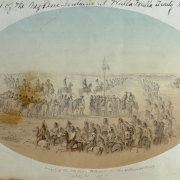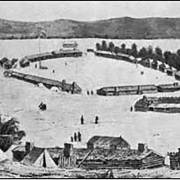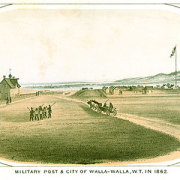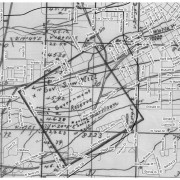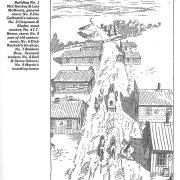Welcome to the Town of Walla Walla & Village of Halfway History Website
Treaty Councils and Forts
In 1855 a treaty council was held in the Walla Walla Valley between Gov. Isaac Stevens of Washington Territory, Superintendent of Indian Affairs Joel Palmer of Oregon Territory, and many of the upper Columbia and Snake River Indian tribes.
The council opened on May 29, 1855 on the north bank of Mill Creek in what is now downtown Walla Walla, and concluded 13 days later on June 11 with the signing of three treaties establishing the Yakama, Nez Perce, and Umatilla Indian Reservations, and the ceding of all remaining tribal lands to the United States.
In 1856, during the Yakima Indian War a second Walla Walla Treaty Council was held in the upper Mill Creek area, resulting in the establishment of Fort Walla Walla by the U.S. Army, first as a small stockade adjacent to the treaty council grounds in the upper Mill Creek area, and then in October as a larger cantonment on the grounds of the 1855 treaty council just east of the current intersection of First & Main in downtown Walla Walla.
In 1858, the final Fort Walla Walla was built on the hill west of the Mill Creek cantonment where the U.S. Veterans Medical Center is now located.
The Village of Halfway
In the fall of 1858 Harry Howard together with a Mr. Parkeson built a log saloon in the vicinity of what is now 12th and Poplar in Walla Walla, halfway between the new Fort Walla Walla on the hill to the west, and the old Fort Walla Walla where Mill Creek crosses the Nez Perce Trail at First and Main.
This saloon became known as the Halfway House. Others soon built around it thinking that a town would be founded there. These entrepreneurs laid off a plaza for the village of Halfway and built facing it. The additional businesses located at Halfway were Michael Kenny, a saloon, William Terry, the Bank Exchange saloon, Mahan and Harcum, a store, James Buckley and Thomas Riley, a saloon, and a bakery operated by a Mr. Meyo.
In a competition that developed between the village of Halfway and a number of other merchants who had built near the old cantonment on Mill Creek, in the end everyone realized that packers were bound to go to Mill Creek to camp and while there tended to trade at the nearest store or saloon.
As a result, those on the creek had the advantage, and the merchants at Halfway moved their establishments to Mill Creek, where the town of Walla Walla was founded in November, 1859.
The Town of Walla Walla
The first building erected on Mill Creek after Fort Walla Walla was a log structure constructed in the summer of 1857 by William McWhirk on the north side of Main Street where Second now crosses it.
The next building was a store of poles and mud erected by Charles Belman in the spring of 1858 on the north side of Main between the creek and Second Street. The third building was made of slabs set endways in the ground and covered with shakes on the south side of Main at what is now Third, put up by Lewis McMorris for Neil McGlinchey in April 1858.
The first actual house constructed in Walla Walla with boards, a floor, and glass windows was built on what is now the northwest corner of Third and Main in 1859 after several of the commercial buildings were put up.
Others soon followed, and on November 17, 1859 the town of Walla Walla was created by Walla Walla County Commissioners.
The first government survey completed in 1860 is superimposed on a current city map below, and shows the wagon road leading to the town from the new fort on the hill.
THE TOWN OF WALLA WALLA IN FEBRUARY 1859
This is what A.B. Roberts remembers when he rode into Walla Walla in February 1859.
“As we rode into the west end of what is now Main Street of the city of Walla Walla we saw first on our right quite a large low building of slabs occupied by Neil McClinchey and Lew McMorris with quite a stock of goods suitable for trade with the Indians, soldiers and others of a frontier country.
A little farther on was a split lumber house with a square top front used as a whiskey shop by Jas. Galbraith, and nearby was a smaller house of the same kind of lumber which was used by Chapman & Shaffer as a meat market. Nearly opposite and near what is the corner of Third and Main was a neat sawed lumber cottage occupied by a Mr. Martin and wife as a boarding house for Baldwin Brothers and their men or help.
A little farther on was a large log building fronting the road used as a saloon by Ball & Stone, and close by a large lumber house with square front was Baldwin Brothers’ licensed traders store, and at what is now Second Street was Frank Worden with a small stock of goods in a house built of poles, and about 100 feet farther was Dick Rackett’s tin shop.”
–A.B. Roberts

